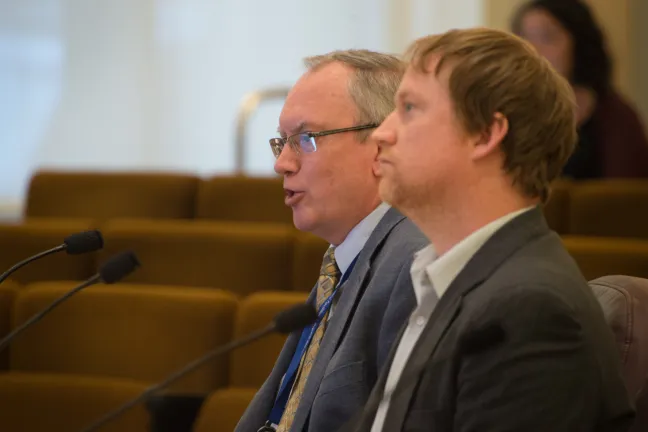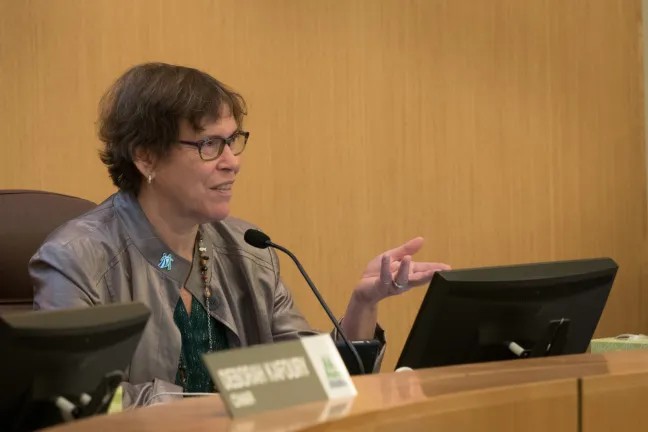Groundbreaking on a new Multnomah County Central Courthouse, which will replace the ailing and seismically unsafe courthouse on Southwest Fourth and Main, is next Tuesday, October 4. Ahead of the long-awaited event, the Multnomah County Board of Commissioners were shown new architectural renderings, updated on innovative and sustainable energy-uses and overall progress on the multi-million dollar project.
Courthouse Project Manager JD Deschamps gave a brief summary to board members on the studies and key decisions in the last four years that have led to the major capital project’s continued success.
“It was with your vision, thoughts and actions and everything you’ve done in making the hard decisions that got us to where we are today,” said Deschamps, while thanking the board on Tuesday.
“Getting the board to decide to replace the current courthouse. The work that was done to get the money from the legislature to become a partner on the project, that was the big turning point in making this project a reality,” Deschamp said.
In the coming weeks, the project team will: host a ceremonial groundbreaking at the new courthouse site on the west end of the Hawthorne Bridge, hold an outreach event for women, minorities and emerging small business owners to contract on the project, and meet with Portland’s Historic Landmarks Commission on the courthouse design. In January, heavy construction will begin with utility relocation.
Deschamps showed board members new renderings of the courthouse, which has an entrance on the corner of SW Madison and First Avenue at the west end of the Hawthorne Bridge. Project architects designed a wood ceiling for the “grand” entry, which begins on the outside of the building and continues inside so visitors have a seamless experience upon entering the building.
“We’ve been meeting with the Regional Arts and Culture Council. They are working on a call for artists to put in significant work in the main entrance,” said Deschamps, as part of the project’s percent for art program.
Every floor of the courthouse has a public waiting room with large windows and views of the Willamette River, designed to provide a calming effect. Corridors will also have wider spaces to accommodate more people, Deschamps explained.
Another rendering, with a view from outside the jury assembly room on the third floor, showed wide open spaces and kiosks on the ground level. Limestone material used outside of the building will be used inside, around the elevator core. Glass will be used on stairways.
“Again, tying the inside of the building and the outside of the building together, Deschamps explained. “We want to make sure that people have a clear line of sight -- the clarity about where they are going and how to navigate.”
As required by state law, 1 ½ percent of total project cost must be invested in solar technology.
Tim Lynch with the County’s Office of Sustainability highlighted the building’s innovative and sustainable features that are meeting project goals, including a clever solution to shuffle energy generated by the courthouse to the county’s neighboring Hawthorne Bridge.
After discovering limitations in the downtown power grid, Lynch said, the project team came up with an innovative solution to maximize the use of energy generated by the courthouse’s solar energy system. Solar power produced by photovoltaic panels on the courthouse roof would feed into a circuit that services the Hawthorne Bridge and help offset energy use from bridge lifts and lighting.
“The way it works is when you’re not using energy that’s being produced, it actually goes back into the grid, so we don’t have to store it on site,” Lynch said. “PGE will take that energy back and use it somewhere else that needs it and they’ll keep an accounting of it.”
Lynch said because PGE’s downtown grid physically can’t take energy back into the system, the team brainstormed this new solution. “So the bridge may not be doing a lift or doing lighting during the day when the photovoltaic panel is producing energy and then at night it will draw down those credits from our utility.”
The commissioners applauded the solution.
“The fact that we have a building that is going to be iconic visually and we’ll have an incredible story to tell around sustainability, my guess is that it’s going to make this a pretty unique and iconic building nationally,” said Commissioner Jules Bailey.
Lynch said energy use per square foot is on track to be 70 percent more efficient than the average commercial building and 55 percent above energy code in the state. The building is meeting the American Institute of Architects 2030 challenge goals to create carbon neutral buildings by 2030. It’s also on track to meet LEED Gold certification for sustainable design and is in reach of a Platinum rating.
Lynch said the county is working with the Environmental Protection Agency and the Oregon Department of Environmental Quality to lower the carbon content of concrete used on the project. The number of diesel engines working on the project will be limited and where possible, electric powered equipment will be used.
The county will also pilot the Clean Diesel Clearinghouse, an online tool to better understand the impact of diesel emissions from public construction projects.
The project team came up with a creative solution to bring sunlight into the courtrooms. They also performed a study to verify that the sunlight would not be in the judges’ or witnesses’ eyes.
“The reality is people spend about 25 percent of their lives in a building or in a workplace,” said Lynch. “So how we build those things, how we maintain them has a significant impact. And many, many studies have shown significant improvements in productivity and brain function in buildings that have more natural light.”
“The savings from the energy on the project are roughly $250,000 a year but the impacts from healthy work environments on worker productivity and decreasing sick days are also very valuable,” Lynch explained.
“I really appreciate the fact that you’re taking a before and after assessment to what the working environment is like in the current courthouse to what it’s like in the new courthouse,” said Commissioner Judy Shiprack. “I think just psychologically, it looks like a great building to work in.”




